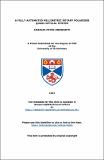Files in this item
A fully automated millimetric rotary polariser quasi-optical system
Item metadata
| dc.contributor.advisor | Lesurf, Jim C.G. | |
| dc.contributor.author | Unsworth, Charles Peter | |
| dc.coverage.spatial | 358 | en_US |
| dc.date.accessioned | 2015-04-16T14:45:43Z | |
| dc.date.available | 2015-04-16T14:45:43Z | |
| dc.date.issued | 1997-06 | |
| dc.identifier | uk.bl.ethos.586908 | |
| dc.identifier.uri | https://hdl.handle.net/10023/6504 | |
| dc.description.abstract | The thesis presents the design, construction, interfacing and performance of a "Fully Automated, Millimetric Rotary Polariser Quasi-Optical System". The system demonstrates that linear, elliptical and circular polarised millimetric radiation can be identified uniquely and that a measure of the ellipticity can be made. Furthermore, the system can analyse the amount of Faraday Rotation and ellipticity that has been incurred upon a linear polarised beam on exit of a magnetic sample. With the above mentioned features, the system was used to determine the suitability of new magnetic materials for use in Freespace Faraday Rotators. This was performed by the new method of 'Faraday Angle Resonance'. The method proved quick and accurate in comparison to a conventional Reflectance Method which is also documented. In addition, the millimetric measurements served to give a further insight into the behaviour of the 'Faraday Angle Resonance' profile in the 'Frequency dependent' region of a magnetic material. This agreed with predictions and served to complement the original work performed by Raum. Additional uses and experimental examples of the system are also highlighted. These includes gaining a further insight into the operation of 'Freespace Faraday Rotators' from direct measurement of the Faraday rotation and ellipticity. In addition, the successful characterisation of a quarter-wave plate, in the form of a 'Millimetric Fresnel Rhornb' was performed. Lastly, the location of the principle axes of a birefringent material was determined and a measurement of the ratio of the refractive indices of the principle axes was undertaken. The system consisted of an 'Automated Oscillator Tuning System' which was developed to automatically tune and optimise the power output of a Gunn oscillator over W-band. A 'Rotary Polariser' was also designed to be used in conjunction with existing quasi-optics and could accurately rotate a polariser grid through discrete increments. The above three instruments together with a Freespace Powermeter, Lockin Amplifier, Boonton Powermeter and EIP frequency counter formed the final system design. All the devices were interfaced to a computer which was used for control and data acquisition. | en_US |
| dc.language.iso | en | en_US |
| dc.publisher | University of St Andrews | |
| dc.subject.lcc | TK7868.P7U7 | |
| dc.title | A fully automated millimetric rotary polariser quasi-optical system | en_US |
| dc.type | Thesis | en_US |
| dc.type.qualificationlevel | Doctoral | en_US |
| dc.type.qualificationname | PhD Doctor of Philosophy | en_US |
| dc.publisher.institution | The University of St Andrews | en_US |
This item appears in the following Collection(s)
Items in the St Andrews Research Repository are protected by copyright, with all rights reserved, unless otherwise indicated.

